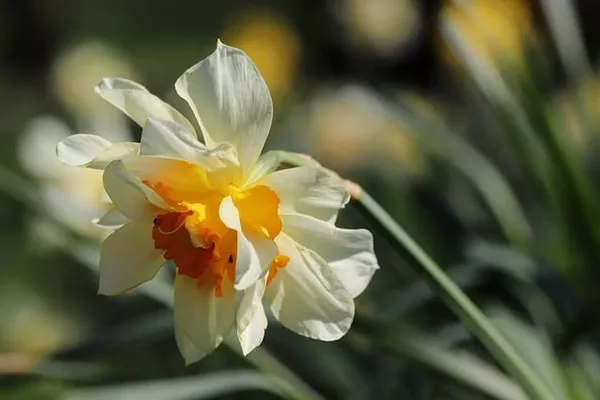The Narcissus flower, renowned for its mesmerizing beauty and rich symbolism, captivates hearts with its delicate petals and enchanting fragrance. Delving into its intricacies unveils a world of botanical marvel and cultural significance. From its appearance to its historical and mythological connotations, the Narcissus flower stands as a testament to nature’s elegance and human imagination.
The Appearance of the Narcissus Flower: A Symphony of Elegance
The Narcissus flower, belonging to the Amaryllidaceae family, boasts a distinct appearance characterized by its trumpet-shaped corona surrounded by six petals. These petals, often white or yellow, showcase a symphony of colors ranging from pale cream to vibrant golden hues, with occasional touches of orange or pink. The corona, adorned with intricate patterns and delicate ripples, serves as the focal point, exuding an ethereal charm that mesmerizes onlookers.
The structure of the Narcissus flower is both intricate and symmetrical, with each component meticulously arranged to create a harmonious whole. Its slender stems rise gracefully from the earth, adorned with glossy green foliage that provides a striking contrast to the luminous blooms above. The flowers, often borne singly or in clusters, sway gently in the breeze, evoking a sense of serenity and tranquility.
One of the most striking features of the Narcissus flower is its intoxicating fragrance, reminiscent of springtime and renewal. The scent, delicate yet invigorating, fills the air with a sense of freshness and vitality, inviting admirers to immerse themselves in its ephemeral beauty.
Cultural and Symbolic Significance of the Narcissus Flower
Throughout history, the Narcissus flower has held profound cultural and symbolic significance, inspiring artists, poets, and philosophers alike. In Greek mythology, the flower is associated with the tale of Narcissus, a handsome youth who fell in love with his own reflection and was transformed into the flower that bears his name. This myth symbolizes the dangers of vanity and self-obsession, serving as a cautionary tale against excessive pride and narcissism.
In various cultures around the world, the Narcissus flower is revered for its associations with rebirth, renewal, and new beginnings. In Chinese culture, the flower symbolizes good fortune and prosperity, often heralding the arrival of spring and the Lunar New Year. Similarly, in Persian tradition, the Narcissus flower is a symbol of the New Year, representing the hope and promise of the year ahead.
In the language of flowers, the Narcissus carries a range of symbolic meanings, depending on its color and context. White Narcissus flowers symbolize purity and innocence, while yellow varieties represent joy and happiness. Pink Narcissus flowers convey affection and admiration, making them popular choices for romantic gestures and declarations of love.
Cultivation and Care of Narcissus Flowers
Narcissus flowers are relatively easy to cultivate and care for, making them popular choices for gardens, parks, and floral arrangements. These hardy perennials thrive in a wide range of climates and soil types, although they prefer well-drained soil and ample sunlight.
Planting Narcissus bulbs in the fall allows them to establish strong root systems before the onset of winter, ensuring robust growth and abundant blooms come springtime. Bulbs should be planted at a depth of 3-6 inches and spaced several inches apart to allow for proper development.
Once planted, Narcissus bulbs require minimal maintenance, with occasional watering and fertilization to promote healthy growth. Deadheading spent blooms encourages continued flowering and prevents the plant from expending energy on seed production.
In regions with harsh winters, mulching around Narcissus plants helps insulate the soil and protect the bulbs from freezing temperatures. In warmer climates, where Narcissus flowers may naturalize and spread freely, regular division of crowded clumps ensures optimal performance and prevents overcrowding.
Uses of Narcissus Flowers in Art and Literature
The Narcissus flower has long inspired artists, writers, and poets to explore themes of beauty, love, and mortality in their work. In literature, the flower often serves as a symbol of fleeting beauty and unrequited love, as seen in the works of poets such as William Wordsworth and Percy Bysshe Shelley.
In art, the Narcissus flower has been immortalized in countless paintings, sculptures, and decorative motifs, its elegant form and symbolic resonance capturing the imagination of artists across the centuries. From classical depictions in Greek and Roman art to modern interpretations by the likes of Salvador Dalí and Georgia O’Keeffe, the Narcissus flower continues to inspire creativity and evoke a sense of wonder and fascination.
Conclusion
In conclusion, the Narcissus flower stands as a testament to nature’s boundless creativity and the enduring power of symbolism and myth. With its delicate petals, intoxicating fragrance, and rich cultural significance, the Narcissus flower enchants hearts and minds, inviting us to contemplate the mysteries of life, love, and the human condition.
Whether adorning gardens, inspiring works of art, or conveying messages of hope and renewal, the Narcissus flower continues to captivate and inspire, reminding us of the beauty that surrounds us and the deeper truths that lie beneath the surface. As we gaze upon its luminous blooms and inhale its sweet perfume, let us pause to appreciate the profound significance of this exquisite flower and the timeless lessons it imparts.


